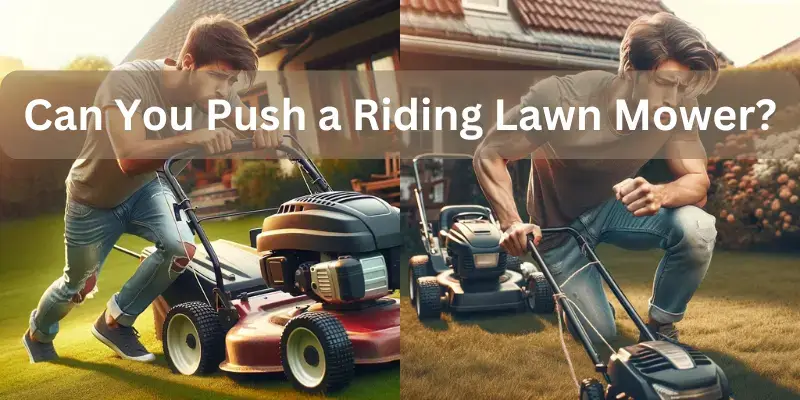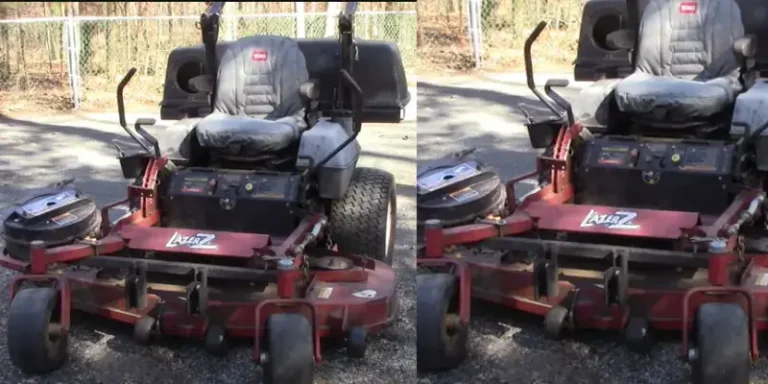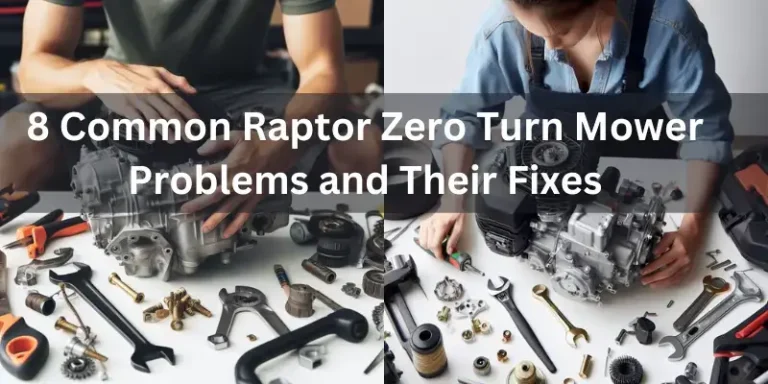Can You Push a Riding Lawn Mower?
When you have a large lawn, a riding lawn mower is often the best tool to keep it neat. However, sometimes these mowers can get stuck or you might need to move them without turning on the engine.
This guide explores the possibility of manually pushing a riding lawn mower, along with safety measures and alternative solutions. Get ready to learn: Can you push a riding lawn mower by hand? Keep reading to find out!
Can You Push a Riding Lawn Mower?
Pushing a riding lawn mower, also known as a lawn tractor, can pose risks and challenges. These machines are heavy and hard to move, especially on uneven ground or slopes. Trying to push them can result in injury, such as muscle strains, falls, or even accidents if the mower tips over.
Additionally, it could cause damage to the mower itself by putting strain on its transmission and other parts. While pushing a riding lawn mower is generally not advised due to these dangers, in certain situations, it may be possible with extreme caution and adherence to safety protocols.
If the mower has a disengagement feature:
If the riding lawn mower is equipped with a disengagement feature, such as a manual bypass valve for the hydrostatic transmission, it might be possible to push it manually. Many modern riding mowers come with this feature, designed to allow the wheels to roll freely when the drive system is disengaged. It’s crucial to refer to the owner’s manual specific to your mower model to understand how to properly disengage the drive system. This manual will provide step-by-step instructions tailored to your mower’s design and features.
On flat, level ground:
Pushing the riding lawn mower becomes notably easier when done on flat, level ground. A smooth and even surface significantly reduces the effort required to move the heavy machine. It’s essential to avoid attempting to push the mower on slopes or uneven terrain, as this increases the risk of accidents or injuries. Maneuvering the mower on such surfaces can be challenging, and there’s a higher likelihood of losing control, especially if the mower starts rolling unexpectedly.
Short distances:
When considering whether to push the riding lawn mower manually, it’s important to limit the distance you plan to push it. While short distances may be manageable, attempting to push the mower for long distances is not advisable.
The weight of the mower and the physical effort required to move it can quickly become exhausting and strain your muscles. Moreover, prolonged pushing could also lead to unintended damage to the mower or increase the risk of accidents. Therefore, it’s recommended to limit manual pushing to short distances whenever possible and explore alternative solutions for longer journeys or when encountering challenging terrain.
Understanding the Riding Mower Transmission Types:
A riding lawn mower transmission is the heart of the mower’s control system. It’s essentially a gearbox that takes the power from the engine and transfers it to the wheels, allowing you to control the speed and direction of the mower. Unlike a car transmission, which uses gears that need to be shifted, a riding lawn mower transmission can come in a few different types, the type of transmission you choose significantly impacts your mowing experience. There are three common types of riding mower transmissions, each offering unique benefits and considerations:
Manual Transmission:
Manual gear drive transmissions operate similarly to a car’s manual transmission, utilizing a clutch and gears to manage speed and direction. They are preferred for their ability to offer precise control over speed, making them suitable for towing heavy attachments and navigating challenging terrain. These transmissions are known for their durability and capability for fine-tuned speed control, making them a common choice for heavy-duty mowers. However, they require more operator skill for shifting and clutching, and transitioning between gears can feel jerky at times, which may be considered a drawback.
Hydrostatic Transmission:
Hydrostatic transmissions function by utilizing a fluid coupling system to seamlessly adjust speed and direction through foot pedals or a control lever, eliminating the need for gears or clutching. They are favored for providing the smoothest operation and simplest control, which is particularly beneficial for maneuvering around obstacles and tight spaces, thus making them a popular choice for residential lawn mowers. The advantages of hydrostatic transmissions include easy operation, excellent maneuverability, and smooth performance. However, they tend to be more expensive than manual transmissions and may not be suitable for heavy-duty towing tasks due to their design.
Automatic Transmission:
An automatic transmission for riding lawn mowers operates similarly to a car’s automatic transmission, employing pre-set gears controlled by a lever or pedal, removing the necessity for clutching. It is preferred for its ability to strike a balance between ease of use and functionality, catering to diverse mowing requirements. The advantages include being simpler to operate than manual transmissions and providing some control over speed ranges. However, automatic transmissions may not offer the same level of smoothness as hydrostatic transmissions and could provide fewer speed options compared to manual counterparts.
Selecting the right transmission:
Depends on your specific priorities. If you value ease of use and maneuverability for residential lawns, a hydrostatic transmission is the ideal choice. For heavy-duty tasks requiring precise control, a manual transmission may be preferable. Consider factors such as your mowing terrain, desired level of control, and budget when making your decision.
Important safety precautions when pushing a riding lawn mower:
When pushing a riding lawn mower, it’s crucial to prioritize safety. Here are some important precautions to follow:
By adhering to these safety precautions, you can ensure a safer experience when manually pushing your riding lawn mower.
Final Thoughts:
While pushing a riding lawn mower manually is possible in certain situations, it’s crucial to prioritize safety. Engage the parking brake, understand the mower’s features, and push straight on flat ground. Limit distances pushed and seek assistance for heavier mowers or uneven terrain. Understanding transmission types helps in selecting the right mower for your needs.

About Naveed A Hashmi
In my childhood, I used to see my parents while working in the land, for these reasons today I have been serving the same as our own tradition and culture. I thus love to stay in it, because I want to learn something advanced and new so that I may improve my farm’s contour and help others with my experience.







